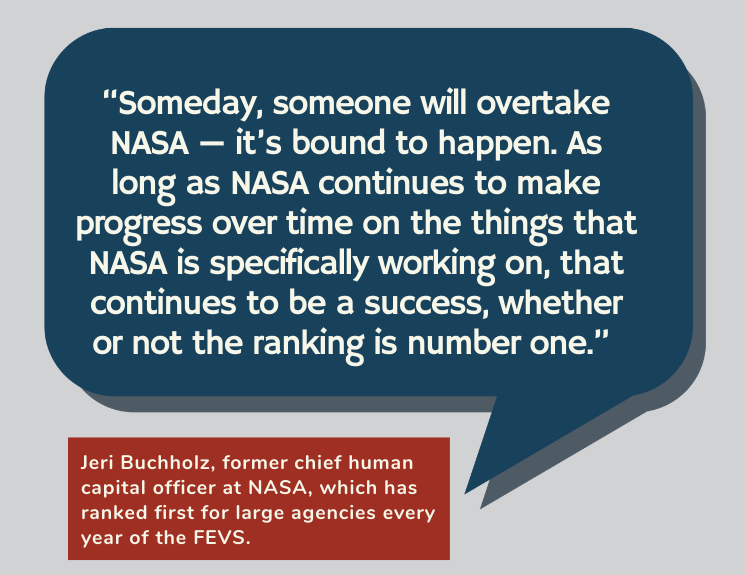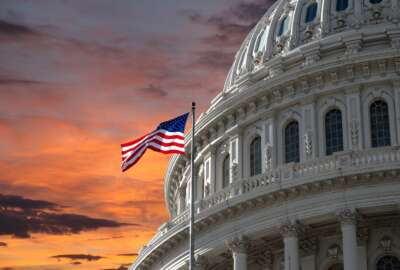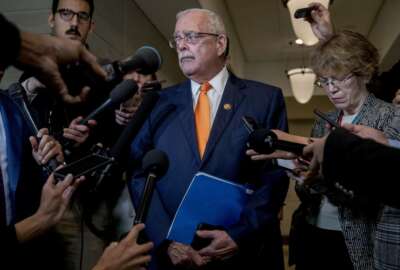How will your agency fare in the ‘Best Places to Work’ rankings?
Agencies may see some changes in this year's rankings for the "Best Places to Work" in the federal government
Agencies are about to get an answer on where they rank for the best places to work in the federal government.
Each year, researchers at the Partnership for Public Service use data from the Office of Personnel Management’s Federal Employee Viewpoint Survey to analyze employee feedback and determine which agencies have the highest and lowest rates of satisfaction in their workforce.
For 2021, the results will likely be a little different.
 This most recent FEVS was the second year in a row that OPM had a delayed and shortened timeframe for administering the survey, largely due to the COVID-19 pandemic. The delay affects the timeline for the Partnership to release its rankings as well. The “Best Places to Work” list for 2021 will come out on July 13.
This most recent FEVS was the second year in a row that OPM had a delayed and shortened timeframe for administering the survey, largely due to the COVID-19 pandemic. The delay affects the timeline for the Partnership to release its rankings as well. The “Best Places to Work” list for 2021 will come out on July 13.
Loren DeJonge Schulman, the Partnership’s vice president for research, evaluation and modernizing government, told Federal News Network that the latest “Best Places to Work” results will consider how agencies address both challenges and opportunities associated with returning to the office after months of increased telework. The rankings will also account for both new and missing parts of the 2021 FEVS.
“Many questions that were previously included in the FEVS were removed, and we saw new questions regarding agency COVID responses. The changes in questions impacted how we calculate workplace category scores,” she said. “For instance, because the FEVS dropped most of the questions we used to compose the diversity category, we’ve dropped diversity from our workplace category analysis, though we hope to re-add it next year.”
The altered questions, along with the delayed timeline, means agencies may see some ripple effects in the Partnership’s breakdown of the results.
“This year, you will be able to see how these changes affect federal employee engagement and satisfaction overall as many federal employees returned to the office, as well as intersecting issues such as work-life balance, how federal workers feel recognized for their contributions, and whether they are able to affect innovative change,” Schulman said.
OPM distributed last year’s survey as many agencies were announcing their return-to-office plans. Scores dropped slightly across the board in the 2021 FEVS, perhaps because many of those reentry plans aligned with the survey timeline.
But there is some good news: Schulman said several agencies were able to secure high employee satisfaction and engagement by managing “safe and productive” work environments for their employees. That could lead to higher scores from the Partnership for some agencies.
It’s also important to note that the Partnership recently changed the way it calculates percent positives for FEVS questions. Starting in 2020, researchers started factoring in when respondents skipped certain questions. That results in slightly more positive results, Schulman said.
Agencies can additionally expect more analysis comparing the federal workforce to the private sector, as hiring continues to grow more competitive.

How can agencies use this year’s results?
The rankings are a way for federal leaders to check for signs of trouble among their workforce, and in the same vein, see where they are finding success in employee satisfaction, Schulman said.
NASA has remained number one on the list for large agencies for about a decade, but that has not always been the case. Jeri Buchholz, former NASA chief human capital officer, told Federal News Network that when she started at the agency, it was ranked fifth.
 “We focused very specifically on three things,” she said. “Recognizing and rewarding innovation, connecting people to each other and the mission, and probably the most important thing was first line supervisors.”
“We focused very specifically on three things,” she said. “Recognizing and rewarding innovation, connecting people to each other and the mission, and probably the most important thing was first line supervisors.”
Ultimately, though, comparing your rankings with other agencies isn’t really what’s important; Buchholz said it’s about making internal progress.
“There will always be people in the top half and always be people in the bottom half, no matter what your score is,” she said. “Someday, someone will overtake NASA — it’s bound to happen. As long as NASA continues to make progress over time on the things that NASA is specifically working on, that continues to be a success, whether or not the ranking is number one.”
Schulman also shared other anonymous feedback from agencies:
“The fact that we have strong ratings is a source of pride and allows us to attract highly skilled and high performing people. We regularly hear that applicants for our jobs are eager to work at [our agency] because of our ranking on the BPTW list,” one agency wrote.
“Over the years, the rankings have helped [our agency] focus on improving the conditions supporting employee engagement. By operationalizing the FEVS data into a comparative metric with other agencies across the federal government, the rankings serve as an indicator in how we are advancing [our] employer brand of commitment to improving the workforce conditions that support employee engagement, empowerment and performance,” another agency wrote.
Regardless of the results we see in just a few days, there is of course always next year. The deadline to take the 2022 FEVS is July 22.
Nearly Useless Factoid
By Amelia Brust
In 1998 a Georgia high school student was suspended for wearing a Pepsi T-shirt on his school’s Coke in Education Day. On the day, Coca-Cola executives — the company is headquartered in Georgia — were visiting as the school was trying to win a competition organized by the corporation for up to $10,000. When told about the incident, a Pepsi spokesperson called the teen “a trendsetter with impeccable taste in clothes,” and told reporters they would “make sure he’s got plenty of Pepsi shirts to wear in the future once we track him down.”
Source: SouthCoast Today
Copyright © 2025 Federal News Network. All rights reserved. This website is not intended for users located within the European Economic Area.
Drew Friedman is a workforce, pay and benefits reporter for Federal News Network.
Follow @dfriedmanWFED






